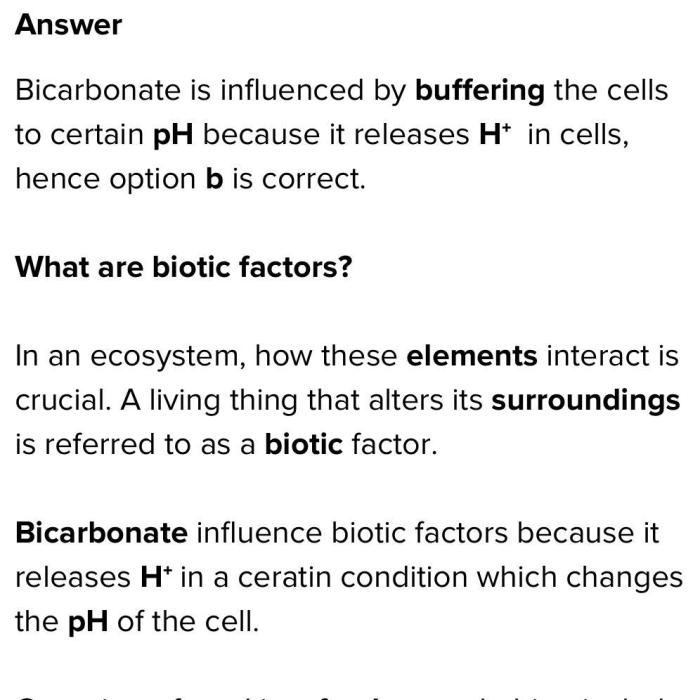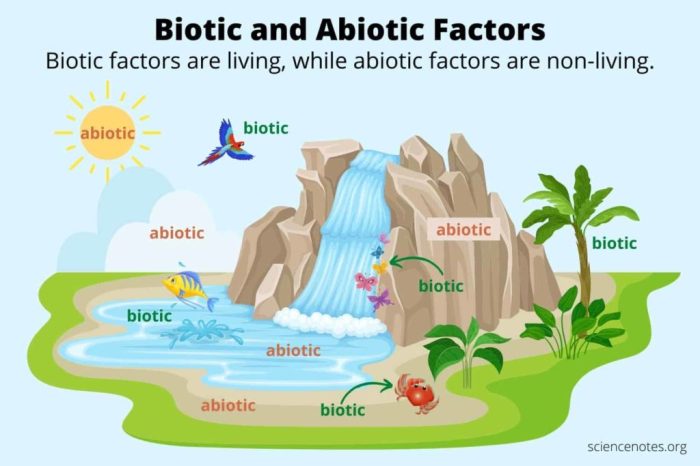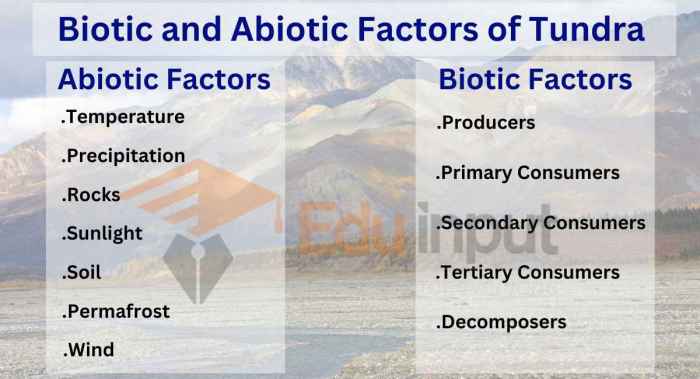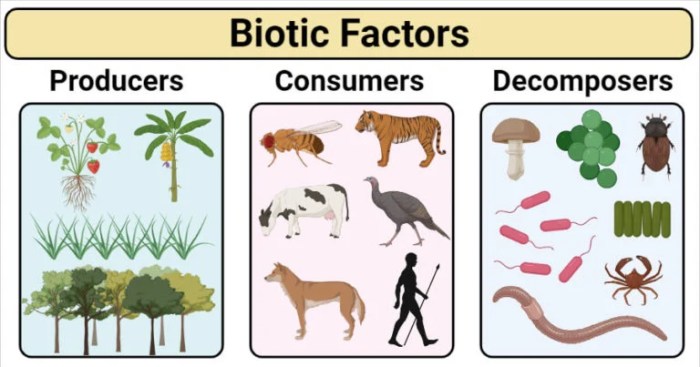How do bicarbonates influence biotic factors? Bicarbonates play a crucial role in aquatic ecosystems, affecting pH, primary production, microbial communities, macroorganisms, biogeochemical cycles, and water management practices. This article explores the multifaceted influence of bicarbonates on biotic factors, providing insights into their significance for aquatic ecosystem functioning.
Bicarbonates, present in natural waters, are produced through various processes, including the dissolution of carbon dioxide and the weathering of carbonate rocks. Their significance lies in their ability to buffer pH, regulate ion availability, and participate in biogeochemical cycles.
Introduction: How Do Bicarbonates Influence Biotic Factors

Bicarbonates are compounds composed of hydrogen, carbon, and oxygen, typically found in the form of HCO 3–. They play a significant role in aquatic ecosystems, influencing various biotic factors that shape the health and functioning of these environments.
Bicarbonates are produced through the dissolution of carbon dioxide (CO 2) in water, a process mediated by the enzyme carbonic anhydrase. They are also generated as a byproduct of respiration and photosynthesis by aquatic organisms. Bicarbonates are consumed in the process of calcification, where they are used by organisms to build shells and other calcium carbonate structures.
Influence on pH
Bicarbonates act as a buffer in aquatic ecosystems, helping to maintain a stable pH. They neutralize both acids and bases, preventing extreme fluctuations in pH that can be detrimental to aquatic life. When acids are added to water, bicarbonates react to form carbonic acid (H 2CO 3), which dissociates into H +and HCO 3–, reducing the H +concentration and maintaining pH.
Conversely, when bases are added, bicarbonates react to form carbonate ions (CO 32-), which combine with H +to form HCO 3–, reducing the OH –concentration and maintaining pH.
Changes in bicarbonate concentrations can affect pH and the availability of other ions. For example, increased bicarbonate concentrations can lead to higher pH, while decreased bicarbonate concentrations can result in lower pH. These changes can influence the solubility and speciation of other ions, such as calcium and iron, affecting their bioavailability to aquatic organisms.
Impact on Primary Production
Bicarbonates are essential for primary production in aquatic ecosystems. They serve as a source of inorganic carbon for phytoplankton, the primary producers in these environments. Phytoplankton use bicarbonates to synthesize organic matter through photosynthesis, converting CO 2into carbohydrates and other organic compounds.
The availability of bicarbonates can limit phytoplankton growth and productivity, particularly in oligotrophic waters where carbon is scarce.
Bicarbonates affect photosynthesis and carbon assimilation in several ways. They provide a source of dissolved inorganic carbon (DIC), which is the primary form of carbon used by phytoplankton. Additionally, bicarbonates can increase the pH of the surrounding water, creating a more favorable environment for photosynthesis.
Furthermore, bicarbonates can chelate certain metals, such as iron, making them more bioavailable to phytoplankton.
Effects on Microbial Communities
Bicarbonates can influence the composition and diversity of microbial communities in aquatic ecosystems. They can act as a carbon source for heterotrophic bacteria, which use bicarbonates to produce organic matter. Bicarbonates can also affect the growth and metabolism of specific microbial groups.
For example, high bicarbonate concentrations can inhibit the growth of some bacteria, while promoting the growth of others.
Bicarbonates can also influence microbial metabolism. They can serve as an electron acceptor for certain anaerobic bacteria, allowing them to respire in the absence of oxygen. Additionally, bicarbonates can affect the production of extracellular polymeric substances (EPS) by microbial communities, which can influence biofilm formation and the structure of microbial mats.
Interactions with Macroorganisms
Bicarbonates can affect the growth, reproduction, and behavior of macroorganisms in aquatic ecosystems. For example, some aquatic plants require bicarbonates for photosynthesis and growth. Bicarbonates can also influence the calcification rates of marine invertebrates, such as corals and mollusks, by providing a source of carbonate ions for shell formation.
Bicarbonate-mediated interactions can have implications for ecosystem functioning. For example, changes in bicarbonate concentrations can affect the abundance and distribution of aquatic plants, which can in turn influence the food web dynamics and habitat structure of the ecosystem. Additionally, alterations in bicarbonate concentrations can affect the calcification rates of marine invertebrates, which can impact the health and resilience of coral reefs and other marine ecosystems.
Role in Biogeochemical Cycles, How do bicarbonates influence biotic factors
Bicarbonates play a role in the cycling of carbon, nitrogen, and other nutrients in aquatic ecosystems. They are involved in the formation of calcium carbonate minerals, which can sequester carbon from the atmosphere and regulate the global carbon cycle. Bicarbonates also influence the cycling of nitrogen by providing a source of inorganic carbon for nitrifying bacteria, which convert ammonia into nitrite and nitrate.
Bicarbonates can affect the fate and transport of nutrients in aquatic ecosystems. For example, they can bind to metal ions, such as iron and manganese, reducing their solubility and mobility in the water column. This can influence the availability of these nutrients to aquatic organisms and affect the productivity of the ecosystem.
Implications for Water Management
Understanding the influence of bicarbonates can inform water management practices. For example, maintaining bicarbonate concentrations within optimal ranges can support aquatic life and ecosystem functioning. In areas where bicarbonate concentrations are naturally low, artificial additions of bicarbonates may be necessary to mitigate the effects of acidification and ensure the health of aquatic ecosystems.
Conversely, in areas where bicarbonate concentrations are excessively high, it may be necessary to reduce bicarbonate levels to prevent adverse effects on aquatic organisms. For example, high bicarbonate concentrations can lead to increased calcification rates in marine invertebrates, which can result in the formation of nuisance algal blooms and other ecological problems.
Questions and Answers
What is the significance of bicarbonates in aquatic ecosystems?
Bicarbonates are essential for maintaining water quality by buffering pH and regulating ion availability. They also play a crucial role in biogeochemical cycles, influencing the cycling of carbon, nitrogen, and other nutrients.
How do bicarbonates affect pH?
Bicarbonates act as a buffer, resisting changes in pH. They neutralize acids and bases, maintaining a stable pH range that is crucial for aquatic organisms.
What is the impact of bicarbonates on primary production?
Bicarbonates are a source of carbon for phytoplankton, the primary producers in aquatic ecosystems. They enhance phytoplankton growth and productivity, forming the foundation of the food web.


